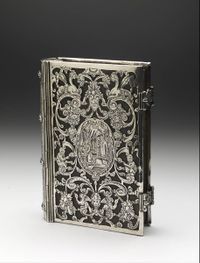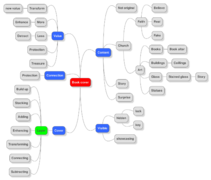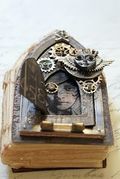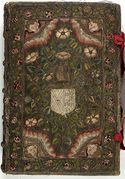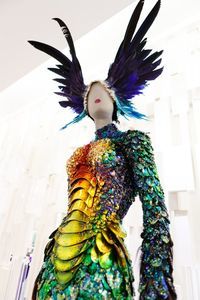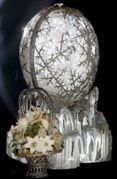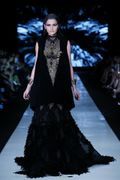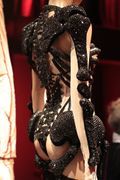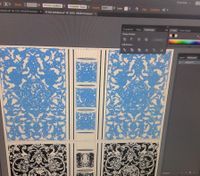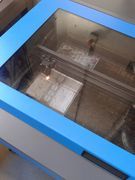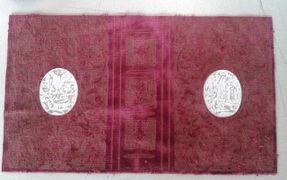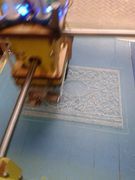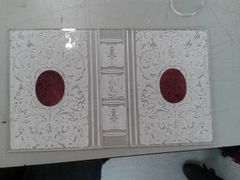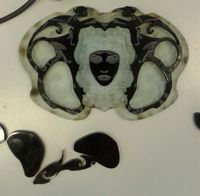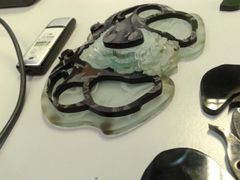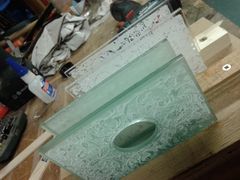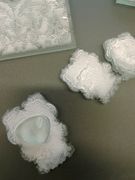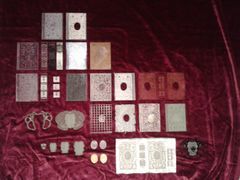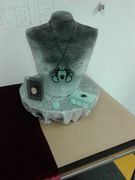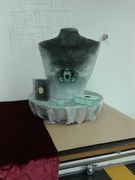User:R. zegelaar
Contents
Robin Zegelaar
Chosen work
After studying the online collection of the Boijmans museum and visiting it, I was drawn to a tiny book cover. The thing I found interesting at first glance was the detail and craftsmanship of the work, that despite its size still drew attention, and the intrigue of what the relation is with the content.
Information about the work
The Boijmans museum did not have a lot of information about the book cover except that it was made around 1600, its dimensions of 12 by 9,2 cm and the material used being silver.
My first starting point was to research more similar books around that time. While browsing I saw the ‘’same’’ book as the one I was researching except it is part of the MET museum. I quickly unraveled this mystery as the MET museum did have more information about the cover. It turns out it is part of a series (three books) and the one from Boijmans is the biggest one. The one in the MET is the smallest and the third one is around the same size as the MET one with the addition of being converted into a box.
Furthermore I discovered the book cover is from 1610-1620 and contains a Nineteenth-century text, Solide Dévotion, sanctifiée par la prière (Turnhout, 1805). It has no hallmarks but there are similar book covers, presumably from the same master. The high quality and style have been determined to originate from Amsterdam. Also the contents of the book in the MET museum are original and printed by Abraham Huijbrecht’s in his Amsterdam workshop called In Den Dortsen Bijbel. This was also an indicator for the time and place of its origin.
The time it was made is in the beginning of the Dutch Golden Age. When the Dutch trade, military, science and art were among the most acclaimed in the world. This is really reflected in the craftsmanship, the amount of details and aura of value, it feels precious.
Research
What do i find interesting about the object and what can i compare it too?
The amount of detail and craftsmanship is what drew me to the object but also the value of the cover intrigues me. And I don’t mean the monetary value rather the meaning of the value.
Digging deeper in the value, does an object that holds another object within value? Is it more or less than the content or does it give more value to the content.
One of the things I thought about was treasure and the relation with the treasure chest.
Treasure chest. The inside is valuable but it is signified with the treasure chest surrounding it. Also if you put something in a treasure chest it gains value because it is inside a treasure chest so it must be important. A time capsule, filled with keepsakes, memories etc. can also be considered a treasure chest but is in stark contrast with the typical pirate treasure filled with gold and has a more emotional value.
The other thing that popped in my mind was Faberge eggs. I have always admired the eggs and feel they have a similar feeling to the book cover, they however really have an important connection to the inside, the treasure. And even though they have a more symbiotic relationship they can be viewed from different perspectives. Is the egg surrounding the treasure just a pretty empty vessel or an important messenger, maybe even equals?
If I relate it to fashion you can see clothes as the object that holds another object inside, namely the person wearing it. And clothes have the same diverse effect that the book cover does. It can provide protection, it can be practical, it can enhance the value of the inside or decrease depending how you look at it. It can transform the person wearing it.
So to answer the question why the book cover is in a museum depends on the person you ask, it is in the eye of the beholder. Does it signify wealth? An important moment in time? Is it of religious value or is it a mockery? Craftsmanship or art or both or all of the above?
Approach
I want to emphasize the cover and its importance. Using the technique of lasercutting, my goal is to create a feeling of craftsmanship and value with an cold machine.
My first test was planned to be with fabric but after using photos of the object, which I enhanced in photoshop to create a higher contrast and make the details more visible, the process gave me insight in the use of the image. I could not reproduce the image in fabric as I planned to as the fabric would fall into pieces if I cut it through the entire material. I had the option to try it on a thicker fabric but my first idea was to have it translucent and a thicker fabric would eliminate that aspect. However engraving was still a possibility and I decided to give that a try. Looking for other suitable media, acrylic sheets (perspex) came to mind. It would retain the translucency, give it a breakable appearance but still retain the rigidness the original object has. I transported the enhanced image into illustrator and using the trace option and playing with the settings to get the highest detailed version without too much unnecessary noise (fixing the last details by hand to get it as close as I could to the original. I made three different versions of the image; a line image, a detailed engraving that would engrave the black parts of the image and a less detailed version in case the laser could not get the detailed one as I wanted it to be.
I got the basic instructions with the laser printer in the digital lab and got started.
My findings were that the image, although very clear, did not have the value I was looking for. It simply remained an engraved image. I was very impressed with the level of detail the laser can put out though, even the smallest of details were clear.
My next steps are to create layers that together form the cover. Looking back at the mindmap I created at the beginning there are various words that can be inspiration for the layers.
Diving further in the whole valueable outside idea, I removed the inside and even the functionality as a book cover. It will undergo a transformation to a valuable object without function besides the aesthetic one. However this also gives it its value, it is a stand alone object with value without being decorative, protective or usefull for the inside which it was previously.
I did some testing with the acrylics adding; paints, nailpolish, wax, powders, pencil and combining it with a different material. One of my choses was velvet because it captures the richness of the era the book came from and has a luxurious aura.
The velvets I tested with were two different kinds one is part synthetic part organic quite stiff and thick and feels durable, it is also 20 year old fabric. The other velvet is a cheap synthetic kind recently made and has a high shine, it is also less stiff and has quite a thin backing. The red velvet creates a nice looking image with contrast that is more visible on how the lights hit the fabric (increasing and decreasing value). The silver however is a whole different story. I thought it would look cheap but it actually creates an interesting texture and because of the synthectic fibers melts the backing creating a more sturdy result where it has been laser engraved.
Besides testing further with acrylics I also attempted 3d printing. This stems from the different layers creating something valuable together. It is interesting to combine laser cutting with 3d printing because one removes material while the other builds material. My first 3d print of the medallion was a failure; I created it using an open source code found at instructables.com (3D Printed Photograph, by amandaghassaei). Although I liked the raster it created and how it transformed the image into something more organic looking, even though it was made by a machine. My second attempt was the front of the cover without the medallion and I like this much more because it has a sense of fragility to it and you can see the original but at the same time its abstract.
I further developed the idea of using the image as a sort of texture to 3d print and eventually it became like an organic rock formation that found its way from the print. It created an abstract crystal like texture that enhances part of the book cover value. Even though it is build up mainly from plastics the materials are transformed.
One of the last things I did for my reproduction was looking for ways to enhance the feeling of value further, I attempted this with engraving deeper so there is more of a relief instead of a light barely touchable texture. Also for the construction of the book I found out how they make aquariums with acrylics and decided to use that same technique on the book covers. The method they used was acetone which melts part of the plastic and combines it. One of the less appealing parts of this method was how it affects the acrylic (as I later found out). Because the acetone is so strong it bites in the plastic and corrodes the top layer resulting in a finish that is not as perfect as the acrylic was before. But I also like the effect because it adds more depth to the piece; it is not slick and too perfect but has more of a personality.
Transformation
The transformation idea stems from the layers stacking and adding to each other like the book cover. I wanted depth but also the idea of an inlay (like wooden chests from the 1600s), so I played with the settings for the laser cutter, changing it so it would engrave to a deeper level, resulting not only in a more touchable texturized surface but also enabling parts to be inlayed but still sticking out creating depth. After creating the image to use for the necklace, I separated several layers but also created engravings that would continue on each layer connecting it as a whole. The finished piece consists of several layers each unique yet fitting together and connecting with each other to create one final object. Valuable parts that create a more valuable piece together.
Presentation
For the presentation I went back to the beginning of my research and was inspired by how the museum acquired the piece in the first place. This was through an auction. The connection between an auction and value is what made me decide on the use of an auction like style for my presentation. At an auction the value is in the eye of the beholder and the current market, what is someone willing to give up to aquire a valuable object.
Statement
File:Robin Digital craft statement.pdf
Tools of the trade
Fashion celebrates the past while looking at the present and the future. The role newer methods play is how to make it relevant to the now and revisiting its original value.
This led me down the path of evolution. What if humans cant evolve fast enough or we have different needs? Newer technologies can play a significant part in how to deal with evolution, they can fill the gap of what there is and what is needed/ wanted. In class I got the suggestion to look at a book of Susan Blackmore, dealing with meme. In short meme is copying certain traits. Meme can be anything, from genetics to cultural which i find fascinating as fashion uses copying traits frequently in the form of trends. Trends have a lifecycle after which they disappear, but most of the time they are reincarnated in a later period. When they do reappear they are envisioned in a contemporary way, using technologies, ideas, knowledge of that time.
My first idea was looking at evolution and incorporating different species to find a solution to a certain problem (a huge world catastrophe). After refining my idea it would be a world where the catastrophe has happened and the results are part of daily life, a mix of reality and fiction, practicality and fantasy. After a conversation I chose to focus on global warming alone and then specifically the rising water. Thinking what would be part of that life are things like crossing the street without getting your clothes wet or walking the dog in water of a meter high. The thing that is important are the design components, their function and the type of materials (seeing as global warming will change the environment there will be changes in the use of textiles/ materials). Cotton for example can take more than 20,000 litres of water to produce 1 kg, which will be a very high toll on the use of water, which will become scarcer in the years to come. That was when I started thinking about using materials like leftovers, durable materials or recycled/ recyclable materials.
I created some sketches showcasing ideas that could be part of that ‘’daily life’’. Some practical, some pure fiction and some on the edge of reality.
But after a discussion during class I adjusted my direction and fine-tuned my idea.
Leaving the purely water focused idea behind I started from the changes that global warming will bring us. The research I did showed various things from well-known problems to more elusive ones.
Global warming brings serious changes in the environment. Most of us know that the sea level is rising and the polar cap is melting, but the shocking thing to me was how fast it happens. By 2100 researchers expect a rise in sea level of 3 to 6 feet, which is devastating to coastal areas (Florida would be mostly flooded). Other problems are ocean acidification which results in diminished sea life, a temperature rise which will not only bring warmer weather but also more extreme weather changes and storms, migration of wildlife and flora to different regions (or simply the extinction of certain species), and drink water that is rapidly depleting (which usually takes a backseat when talking about global warming).
Learning these facts I decided to go with the weather changes, seeing how this will be a major influence on fashion, trends and seasons. In one of the first classes, where I presented my idea, we talked about god mode and that I essentially take over evolution because I shape the evolution myself. In evolution changes come because they need to change, there is no end goal just a survival. But fashion is more like a second skin, not just for protection. Fashion can be an expression, show social and economic status it can even be political.
Tool
My tool will be a garment that can adapt to the changing climate through the user, evolve or copy a trait that is wanted at that time.
The thing I love about this idea is how it touches fashion and technology in a similar manner; both make use of evolution and copying traits and are in a constant motion. It also means the two can be combined and react to each other, there is a demand in fashion and technology is created to meet that demand, a new technology is created and can be adapted to fashion etc.
The tool will be a visualization of adapting through the user, specifically focused on global warming. The starting point will be a base module, the first brick or gene in the evolution. From thereon you can add, detract and change the base to meet your needs. Looking at global warming it will not only touch on the practical needs but also the question of material. My various experiments use waste and or uncommon materials and use them in the tool. Testing things like insulation, protection against rain, new look at fur etc. Different evolutions’’ that can be used on the tool.
Short summary
My tool is a base module. It can adapt/evolve to the users visions and needs. A discussion during the development sparked the idea. People get to choose their own evolutions. It connects to the meme I was talking about in the begin fase where certain traits are copied. Eventually it could become opensource and everyone can contribute their own evolution. This way fashion and new technologies can continue their path together and take advantage of the drive to create new things and the things available. I chose to focus on global warming and the use of different materials that are transformed into clothing.
Research document
File:Robin zegelaar 0850198 digital craft research document adaptive clothing.pdf
Version 2: File:Robin zegelaar 0850198 digital craft research document adaptive clothing version 2.pdf
